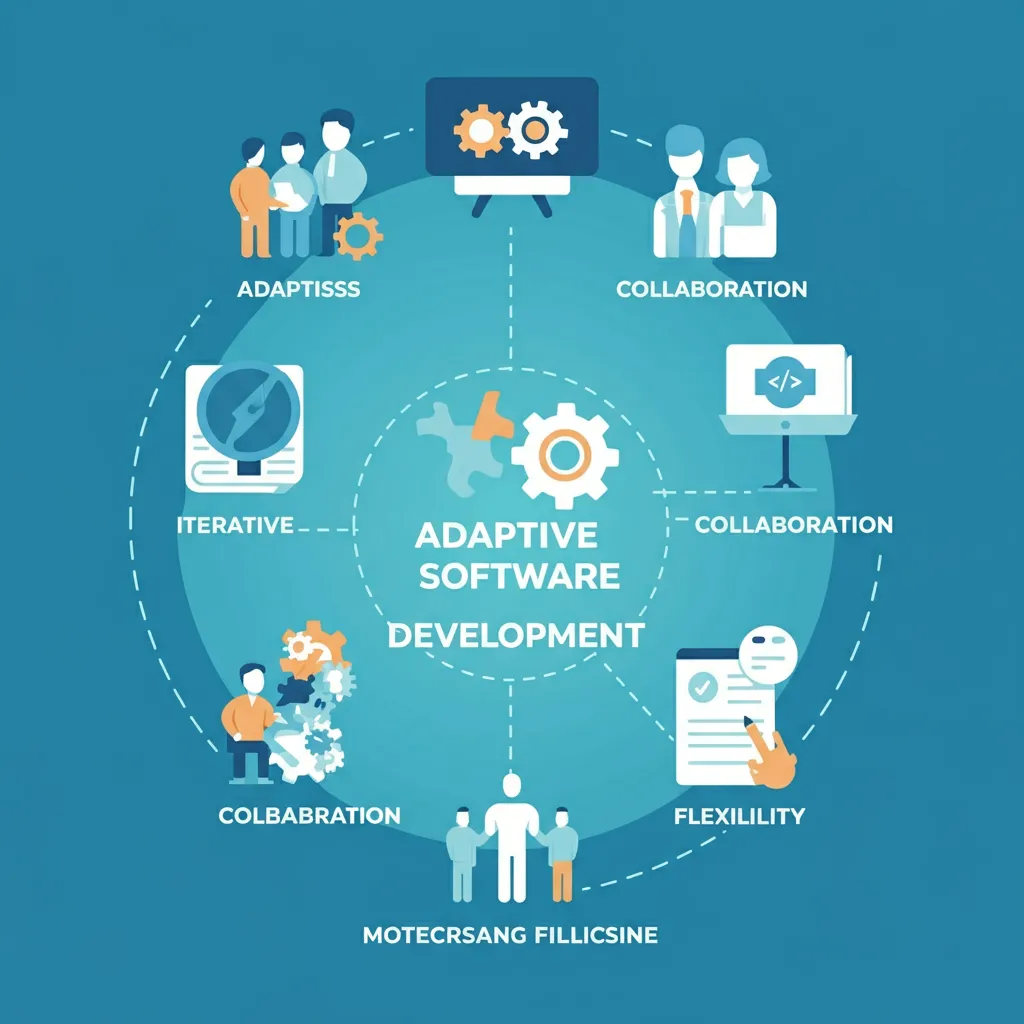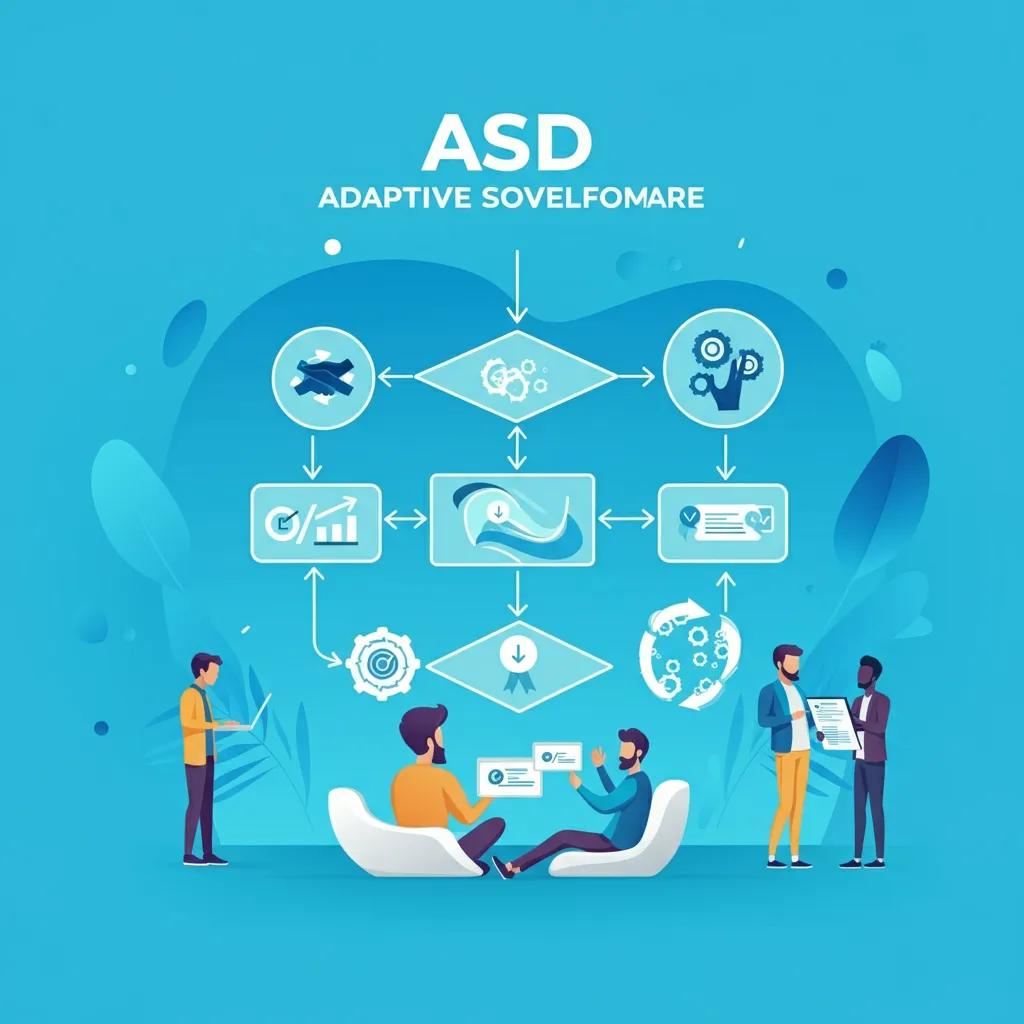Adaptive Software Development (ASD) is a modern, flexible methodology designed to help teams build robust software while responding effectively to evolving requirements. Unlike traditional software development approaches, which often rely on rigid plans, ASD emphasizes continuous learning, collaboration, and adaptability.
It empowers teams to pivot quickly and address challenges as they arise, making it particularly valuable for dynamic industries and complex projects.

This blog explores the key aspects of Adaptive Software Development, including its history, characteristics, phases, advantages, and challenges.
By the end, you’ll understand why this framework has become a go-to choice for many businesses seeking to deliver high-quality software in fast-changing environments.
Understanding Adaptive Software Development
A Brief History of ASD
ASD originated in the mid-1990s, developed by Jim Highsmith and Sam Bayer as an evolution of the Rapid Application Development (RAD) framework. Highsmith and Bayer recognized the limitations of traditional, plan-based methodologies like the waterfall model, which struggled to accommodate shifting requirements.
They designed ASD as a highly collaborative and iterative alternative that thrives in uncertainty.
The release of Highsmith's seminal book, Adaptive Software Development: A Collaborative Approach to Managing Complex Systems in 2000, further cemented ASD’s principles. It also contributed significantly to the broader agile movement, alongside other methodologies like Scrum and Kanban.
Today, ASD remains highly relevant, offering organizations a proven way to manage projects where change is inevitable.
🏗️ ASD vs Waterfall vs Agile
| Feature |
Waterfall |
Agile (Scrum/Kanban) |
Adaptive Software Development |
| Planning Style |
Fixed, sequential |
Iterative |
Speculative, flexible |
| Requirement Handling |
Fixed upfront |
Evolving during sprints |
Assumes uncertainty |
| Change Management |
Rigid |
Managed per sprint |
Embraces change |
| Feedback Cycle |
Late |
Early & frequent |
Built into every phase |
The Core Principles of ASD
Adaptive Software Development is built on three key principles:
● Mission-Focused – Projects are aligned with high-level business objectives rather than rigid, detailed plans.
● -Tolerant – The team embraces change as a part of the process, rather than viewing it as a disruption.
● Continuous Learning – Iterations provide opportunities to learn from both successes and failures, leading to constant improvement.
These principles make ASD a valuable tool for handling the complexities of modern software projects.
Key Characteristics of Adaptive Software Development
ASD sets itself apart from more traditional methodologies through its unique characteristics. Here’s what defines this approach:
● Iterative Development
Instead of delivering the entire software at once, ASD breaks the project into smaller cycles. Each iteration delivers a functional piece of the software, enabling teams to refine features as they progress.
● Timeboxing
Each phase or iteration is time-bound, ensuring the project stays on track without unnecessary delays.
● Collaboration
Teamwork between stakeholders, developers, and customers is vital. ASD thrives on effective communication and mutual trust.
● Customer-Centric Approach
Continuous feedback from customers helps ensure the software meets actual user needs.
● Proactive Risk Management
Risks are identified and addressed early in the project, reducing the likelihood of major roadblocks.
● Self-Organized Teams
Unlike top-down management structures, ASD relies on empowered teams that take ownership of their work and decisions.
The Phases of Adaptive Software Development

ASD divides the development process into three major phases Speculation, Collaboration, and Learning. These phases replace the rigid planning and execution cycles found in traditional methodologies.
1. Speculation
This phase replaces traditional, exhaustive planning with high-level strategic thinking. Speculation focuses on considering “what could be” instead of locking the team into a rigid plan. Key activities during this phase include:
● Defining the software’s overall mission and goals
● Prioritizing high-level requirements
● Creating a loose, adaptable roadmap
● Identifying potential risks and assumptions
2. Collaboration
Collaboration is the action phase, during which teams work together to create iterations of the software. Here’s what happens:
● Developers, testers, and other stakeholders collaborate on iterative builds and prototypes.
● Communication and teamwork are highly emphasized, with feedback loops incorporated into the process.
● Frequent testing ensures that changes align with the project’s mission.
3. Learning
The learning phase allows teams to reflect on each cycle and incorporate insights into the next iteration. This phase includes activities such as:
● Conducting retrospective meetings to evaluate what worked well and what didn’t.
● Making informed adjustments to project priorities.
● Leveraging user feedback to refine functionality.
By repeating these three phases, teams continuously improve their process and deliver higher-quality software.
Learn more about : How to Find Out Who Developed a Website
Advantages of Adaptive Software Development
ASD offers numerous benefits for both development teams and businesses:
● Flexibility and Adaptability
Teams can quickly respond to changes in requirements, technology, or market conditions without disrupting the entire project.
● Improved Product Quality
Continuous testing and feedback ensure that the software evolves to meet user needs effectively.
● Faster Time-to-Market
Iterative development allows for faster delivery of functional features, giving businesses a competitive edge.
● Enhanced Collaboration
Communication between team members and stakeholders creates alignment and reduces misunderstandings.
● Proactive Problem-Solving
Risks are addressed early in each iteration, minimizing the chances of costly errors down the road.
Challenges of Adaptive Software Development
While ASD has significant benefits, it’s not without its challenges. Here are some of the key hurdles teams may face:
● Requires High Skill Levels
Teams need to be highly skilled, versatile, and comfortable with agile principles to succeed with ASD.
● Potential Scope Creep
Frequent iterations and user feedback may result in scope creep if there’s no clear prioritization strategy.
● High Stakeholder Engagement
ASD relies heavily on active involvement from stakeholders, which can be difficult to maintain.
● Cultural Resistance
Organizations new to agile methods may resist the shift from traditional, hierarchical approaches.
● Management of Uncertainty
Teams need to be comfortable operating without rigid plans and managing unpredictability effectively.
When Should You Use Adaptive Software Development?

ASD is best suited for projects characterized by high levels of uncertainty and fast-evolving requirements. It’s a great choice if:
● The project involves innovative or experimental features.
● You need regular feedback loops to identify and integrate user needs.
● Flexibility and adaptability are important to the project’s success.
However, if your project has fixed requirements or stakeholders are unavailable for continuous collaboration, a more traditional methodology might be a better fit.
Final Thoughts
Adaptive Software Development is a powerful, customer-centric approach to software creation. By focusing on iterative development, collaboration, and learning, it meets the demands of fast-evolving industries while delivering high-quality software. While it comes with challenges, adopting ASD often leads to faster delivery, happier customers, and more empowered teams.
To implement ASD successfully, businesses must be willing to embrace change, encourage collaboration, and foster a culture of continuous improvement. With the right mindset and tools, Adaptive Software Development can transform the way your team builds software, helping you stay competitive in today’s dynamic markets.
If your organization is considering adopting ASD, now is the time to evaluate how its principles align with your goals and start reaping the benefits of this innovative methodology.
Whether you’re new to Agile frameworks or transitioning from traditional methods, our team is here to help. Visit New Web Order to explore how we can simplify the adoption process and ensure successful implementation.
Adaptive Software Development FAQ
General Questions About ASD
1. What is Adaptive Software Development (ASD)?
Adaptive Software Development (ASD) is an agile framework designed to build software with flexibility and adaptability to changing requirements. It emphasizes collaboration, iterative development, and continuous learning.
2. How is ASD different from traditional development methodologies?
Unlike traditional methodologies like the waterfall model, ASD replaces rigid planning with iterative cycles. It focuses on flexibility, continuous improvement, and adapting to changes rather than following a fixed, linear process.
3. Who created Adaptive Software Development?
ASD was developed in the mid-1990s by Jim Highsmith and Sam Bayer as an evolution of Rapid Application Development (RAD) to handle uncertainty in software projects more effectively.
Benefits and Challenges
4. What are the main benefits of ASD?
● Flexibility: Easily adapts to changing requirements and conditions.
● Customer-Centric Approach: Encourages continuous feedback for better alignment with user needs.
● Faster Delivery: Iterative development ensures quicker time-to-market.
● Risk Reduction: Proactively identifies and addresses risks early.
● Team Empowerment: Encourages self-organized and collaborative teams.
5. What challenges might I face with ASD?
● High User Engagement: Requires consistent involvement from stakeholders.
● Skill Dependence: Teams need to be skilled and familiar with agile principles.
● Scope Creep: Continuous iterations may lead to expanding project scope.
● Cultural Resistance: Organizations used to traditional methods may resist adopting ASD.
Implementation and Best Practices
6. What are the three main phases of ASD?
The three phases of ASD are:
● Speculation: High-level planning and goal setting.
● Collaboration: Teamwork and iterative development.
● Learning: Reflecting on past iterations to improve future ones.
7. When should I use Adaptive Software Development?
ASD is ideal for projects with uncertain or evolving requirements, those involving innovation or experimentation, or situations that require quick adaptation to market or user feedback.
8. How does ASD ensure continuous improvement?
ASD integrates learning at every phase. Teams use retrospectives to review progress, identify challenges, and adjust both processes and products for better outcomes in the next iteration.
Comparisons with Other Methodologies
9. How is ASD different from Scrum?
While both ASD and Scrum are agile methodologies, Scrum follows structured sprints with predefined goals, whereas ASD uses flexible, learning-driven cycles with an emphasis on adapting to changes.
10. How does ASD compare to Rapid Application Development (RAD)?
ASD evolved from RAD but focuses more on continuous learning and collaboration. RAD prioritizes rapid prototyping, while ASD emphasizes adaptability throughout the entire project lifecycle.
Practical Considerations
11. Do I need specialized tools to implement ASD?
While no specific tools are required, tools for collaboration (e.g., Jira, Trello) and communication (e.g., Slack, Microsoft Teams) can help facilitate ASD processes effectively.
12. Is ASD suitable for small teams?
Yes, ASD works well for small teams as it relies on collaboration and self-organization, making it easier to implement in compact team structures.
13. Can ASD be used alongside other agile practices?
Yes, ASD is highly compatible with other agile practices like Kanban or Extreme Programming (XP) and can be tailored to complement them.
Additional Information
14. How can I train my team to use ASD?
Start by educating your team on ASD principles and phases. Offer workshops or training in agile practices, and encourage a culture of flexibility, teamwork, and continuous improvement.
15. Where can I learn more about ASD?
You can refer to Jim Highsmith’s book Adaptive Software Development: A Collaborative Approach to Managing Complex Systems or explore agile-focused blogs, case studies, and professional training courses.
If you're ready to transform your development process, Adaptive Software Development could be the perfect match for your team.


